“He would eat no fish the day before the hunt, and smoke no tobacco, for these odors are detected a great way off. He rose early, bathed in the creek, rubbed himself with the aromatic leaves of yerba buena, washed out his mouth, drank water, but ate no food.” — Saxton Pope’s account of Ishi’s pre-hunt ritual.
It was hard not to take in the splendor of the mid-October afternoon as I followed my father and son up the trail through the rustling poplar trees. As I watched the leaves flutter in the breeze, I knew that in a week’s time they would be blanketing the forest floor and the trees would be bare, their span of golden beauty only present for a short time. One by one our small group parted ways along the trail, my son and dad’s stand locations already predetermined. My ambush location would be chosen by deer sign and the breeze.
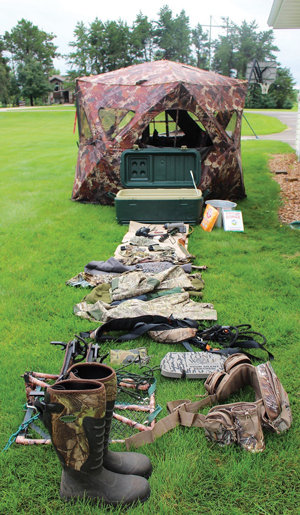
Every year, Chris washes all his gear—clothes, tree stand, bow, and boots—before the season begin. Once dry, he stores all his hunting clothes in the cooler.
I found a location that afforded me the most cover for a close shot to a well-used deer trail coming out of the swamp. After placing my stool against a small tree and carefully matting down a shooting lane through the canary grass, I sat peacefully enjoying the tide-like rhythm of the wind on the leaves. Soon, I started to recognize a back swirl when the wind would reach its highest velocity. I released milkweed into the air and watched it float upward from my location, only to swirl back across the trail I was watching once the wind increased again. Scanning the surrounding area for a better location was fruitless, it seemed, for no matter where I sat the wind would be wrong at some point. Finally, I decided to trust that my scent control regimen would help me if an opportunity arose.
In the last minutes of legal shooting light, I heard a subtle “snap” to my right. My mind was instantly jarred from the quiet, Zen-like state that had washed over me. Slowly panning to my right, my eyes caught the dark silhouette of a lone doe ghosting through the evening shadows. The doe, catching me off guard, had decided to come from the opposite direction I had expected. Somehow, I had lost sight of her in the tall grass and shadows.
After bowhunting for nearly 30 years I’ve probably tried just about every scent control product that’s been peddled by savvy advertisers of outdoor products—scent-containing clothing, scent wafers, cover sprays, scent-eliminating sprays, scent bombs, wicks, and numerous shampoos and laundry soaps. My wife’s favorite is the earth-smelling dryer sheets. “Why wash your clothes if you’re only going to make them smell like dirt again anyway?” she’d chuckle.
I favor hunting on the ground, generally in the swamps of central Minnesota. I find the wind in these areas to be fickle at best. So, by following in the footsteps of the Indians such as Ishi, but drawing a line at a cold creek bath, I try keeping my hunting paraphernalia as simple as possible—a bow, small stool, and a fanny pack with some bare essentials. That includes my scent-control regimen, using common household items. Below is my economic system for keeping scent “reduced,” for in my opinion there is no way human scent will ever be completely eliminated.
Clothing and equipment: A number of years ago I purchased a reasonably priced hundred-quart cooler at a box store. Before opening day each year, I fill the cooler with warm water and approximately one cup of baking soda and one cup of borax. Next, I wash all my early season hunting clothes, packs, boots, and even the contents of my pack and bow. I line dry everything, and once it’s dry I store my clothes in the cooler. My pack, stool, boots, and any other larger items I keep stored outside under my deck. When transporting the bigger items in my vehicle, I stow them in cheap totes. As the season progresses, heavier clothes will be washed as needed before use.
While at hunting camp I store my clean clothes and all my hunting equipment in a ground blind away from camp smells. I keep the windows open for fresh air circulation. As the temperature cools later in the season, I like to run a small heater in the morning before changing to reduce the shock of pulling on freezing clothes in the frosty darkness.
Cover Scents: As stated earlier, I’ve tried numerous chemically produced cover scents over the years with varying success but have decided that nature is where the deer live, not chemical labs. One day while bowfishing a gentleman approached me at the boat landing and commented on the fact that I was using a recurve. Soon we were swapping hunting yarns and tactics. During the conversation he asked if I had ever used boiled acorns for cover scent. When I admitted that I hadn’t, he stated that acorns “work great,” and of course they are free. We have large white oaks in our yard, so each fall their bounty starts accumulating on the driveway right around the opening of bow season. I simply grab a shovel full of the acorns crushed by vehicle tires and then dump them in an old pot and boil them for 20 minutes or so. I let my acorn stew cool, then strain and pour the brown liquid into a spray bottle. Before each hunt I spray down my boots and pant legs.
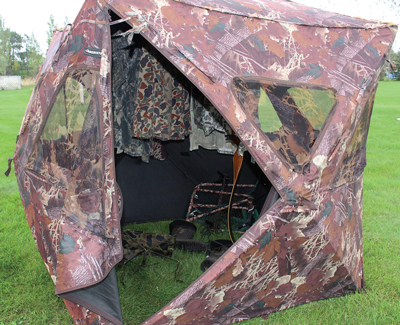
In camp, all the gear is stored in his blind.
I’ve read how people use pine or cedar boughs in a garbage bag with their hunting clothing to keep them fresh. First, I have yet to find a garbage bag that doesn’t stink. Most are scented with something these days. Even if they are “unscented” they have a strong plastic odor, thus the use of my unscented cooler. When using pine boughs, be careful so that the cut branch doesn’t ooze sap all over your hunting clothes. To avoid this annoying problem I buy a cheap mesh laundry bag, fill it with leaves and boughs from trees in my hunting area, and place the bag on the bottom of my cooler with my hunting clothes on top. Sticks and leaf debris won’t mix into your clothing and make a mess, and any sap will run to the bottom of the cooler instead of on your clothing. Periodically, I’ll switch out newly fallen leaves into the mesh bag.
If rain is in the forecast, I purposely hang my hunting clothes on the wash-line to give them nature’s rise cycle. If time doesn’t allow for line drying and my clothes do have to go in the dryer, I’ll half fill an old pillowcase with leaves and tie a knot at the open end. Once my hunting clothes have completely dried, I’ll toss the pillowcase in for 10 to 15 minutes on low tumble dry heat. No more buying dirt scented dryer sheets, honey!
If the hunting gods happen to allow me an early season deer, I’ll skin and dry the two back hocks. Whether the deer is a buck or doe doesn’t matter to me. I just want the smell of deer. These I’ll drag with me throughout the rest of the season on an attached string. While hunting I may place them at strategic locations, hung from a branch upwind of my location or placed directly on a deer run where I want a deer to pause for a shot. When not in use I store them in Ziplock baggies in the freezer. As the season nears the rut, I may apply commercially produced scent to the hocks to juice them up a bit. A better alternative would be to use the real thing. Don Thomas mentioned in a past article the use of a syringe to remove the urine directly from a deer’s bladder with no mess.
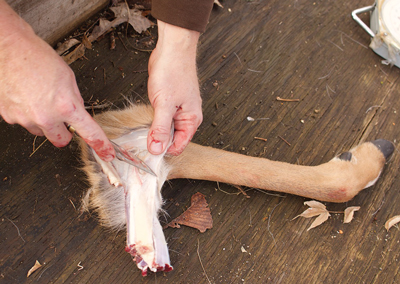
If he kills a deer early in the season—buck or doe—Chris removes the tarsal glands and drags them around behind him all through the season to leave deer scent.
Body odor: There’s no way around it; humans stink, which is why so many products we use today contain some form of perfume. There are many companies that make non-scented soaps. You should find some at your local box store, or a quick online search will reveal many options. I generally shower with a non-scented soap, then use a 50/50 mix of baking soda and cornstarch for my armpits and groin area. I keep a small baggy of this mixture in my pack so that when I reach my hunting location, I can grab a handful, fluff it in my hair, and reapply it to my body if the walk was strenuous or the weather hot.
Since I mainly hunt swamps, I generally just use the mud I’m sitting in for face paint. As it dries and flakes off,I just reapply. I also like to keep my facial hair trimmed tight, along with a short haircut to reduce scent-accumulating hair follicles. Age is naturally helping me with this problem, mainly on top.
Wind indicators: I’ve used many kinds of puff bottles over the years, but often lose them somewhere or have the bottle simply run out of powder. The powder—corn starch, for example—also only seems to carry for 10 or 20 yards and then dissipate. Milkweed, in my area, is readily available and ready to fly by hunting season. You can watch it for long distances, which enables you to note thermals and eddies in the air current. I’ve found that an old coin purse works best for keeping my milkweed handy. I used to tie a feather or thread to my bow tip, but would often lose it early on during the season while pushing through thick brush. It only gives you wind direction where you are standing, not 50 yards downwind where the air currents may be different. Even so, it certainly doesn’t hurt to have one attached. Note: To avoid spreading invasive weeds, do not use milkweed pods in areas where the plant is not native, which includes much of the West.
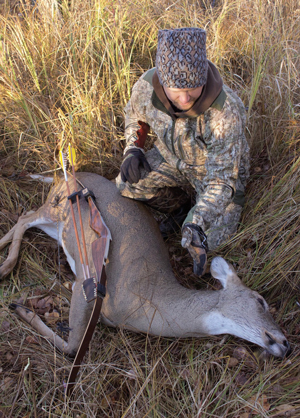
The author with a doe taken on the hunt.
Diet: This may seem “over-the-top” to some, but I believe “you are what you eat.” If on the night before a hunt you consume multiple brats covered in sauerkraut and onions and washed down with a couple of dark micro brews, you will have a distinct odor the next day coming out of every pore. For breakfast, skip the bacon and eggs and have a hearty bowl of oatmeal instead. Sticking to fruits, vegetables, chicken, nuts, and water the night before a big hunt may not only keep you from oozing odor the next day but may also keep you from having to prematurely end your hunt for a run to the outhouse!
As quickly as the doe had disappeared, her head reemerged in my shooting lane. She came to a careful stop 11 yards away, her head behind the grass and her body perfectly framed in my shooting lane. I could hear her trying to suck in my scent, which was lightly wafting in her direction. Those few seconds afforded me all the time I needed, for the old Browning recurve came smoothly to my anchor, and with a “plunk” of my wooden shaft she was bounding away. Forty yards later she breathed her last. The cooler could now be used for the purpose it was originally designed for—cooling and transporting fresh venison!
Chris enjoys time in the woods with camera, bow, or flintlock.
Equipment Note: On this hunt, the author used a 1972 Browning Fury at 45#, with homemade Surewood shafts and Bear Razorheads.




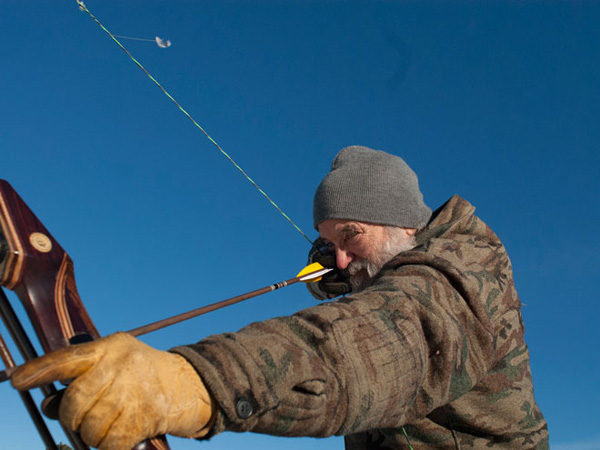

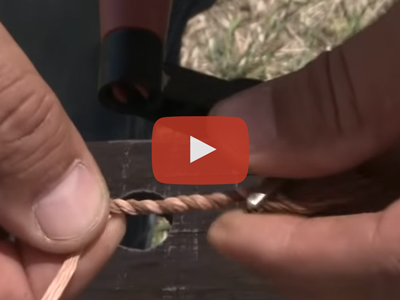
Leave A Comment